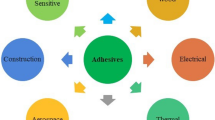Abstract
Resol resins are used in many industrial applications as adhesives and coatings, but few studies have examined their thermal degradation. In this work, the thermal stability and thermal degradation kinetics of phenol–formaldehyde (PF) and lignin–phenol–formaldehyde (LPF) resol resins were studied using thermogravimetric analysis (TG) in air and nitrogen atmospheres in order to understand the steps of degradation and to improve their stabilities in industrial applications. The thermal stability of samples was estimated by measuring the degradation temperature (T d), which was calculated according to the maximum reaction rate criterion. In addition, the ash content was determined at 800 °C in order to compare the thermal stability of the resol resin samples. The results indicate that 30 wt% ammonium lignin sulfonate (lignin derivative) as filler in the formulation of LPF resin improves the thermal stability in comparison with PF commercial resin. The activation energies of degradation of two resol resins show a difference in dependence on mass loss, which allows these resins to be distinguished. In addition, the structural changes of both resins during thermal degradation were studied by Fourier transform infrared spectroscopy (FTIR), with the results indicating that PF resin collapses at 300 °C whereas the LPF resin collapses at 500 °C.







Similar content being viewed by others
References
Alonso MV, Oliet M, Rodriguez F, Astarloa G, Echeverria JM. Use of a methylolated softwood ammonium lignosulfonate as partial substitute of phenol in resol resins manufacture. J Appl Polym Sci. 2004;94(2):643–50.
Benar P, Gonçalves AR, Mandelli D, Schuchardt U. Eucalyptus organosolv lignins: study of the hydroxymethylation and use in resols. Bioresour Technol. 1999;68(1):11–6.
Olivares M, Aceituno H, Neiman G, Rivera E, Sellers TJ. Lignin-modified phenolic adhesives for bonding radiata pine plywood. For Prod J. 1995;45(1):63–7.
Cho D, Il Yoon B. Microstructural interpretation of the effect of various matrices on the ablation properties of carbon-fiber-reinforced composites. Compos Sci Technol. 2001;61(2):271–80.
Mao J, Chang J, Chen Y, Fang D. Review of phenolic foam. Ind Eng Chem Res. 1998;15(3):38–43.
Mouritz AP. Post-fire flexural properties of fibre-reinforced polyester, epoxy and phenolic composites. J Mater Sci. 2002;37(7):1377–86.
Tugtepe M, Özgümüş S. Modified phenol-formaldehyde novolac resins: synthesis and thermal oxidative degradation. J Appl Polym Sci. 1990;39(1):83–101.
Gao J, Xia L, Liu Y. Structure of a boron-containing bisphenol-F formaldehyde resin and kinetics of its thermal degradation. Polym Degrad Stabil. 2004;83(1):71–7.
Chen Y, Chen Z, Xiao S, Liu H. A novel thermal degradation mechanism of phenol-formaldehyde type resins. Thermochim Acta. 2008;476(1–2):39–43.
Zárate CN, Aranguren MI, Reboredo MM. Thermal degradation of a phenolic resin, vegetable fibers, and derived composites. J Appl Polym Sci. 2008;107(5):2977–85.
Budrugeac P, Segal E. Application of isoconversional and multivariate non-linear regression methods for evaluation of the degradation mechanism and kinetic parameters of an epoxy resin. Polym Degrad Stabil. 2008;93(6):1073–80.
Looyeh MRE, Samanta A, Jihan S, McConnachie J. Modelling of reinforced polymer composites subject to thermo-mechanical loading. Int J Numer Meth Eng. 2005;63(6):898–925.
Núñez-Regueira L, Villanueva M, Fraga-Rivas I. Activation energies for the thermodegradation process of an epoxy-diamine system. J Therm Anal Calorim. 2006;83(3):727–33.
Zhang Z, Gu A, Liang G, Ren P, Xie J, Wang X. Thermo-oxygen degradation mechanisms of POSS/epoxy nanocomposites. Polym Degrad Stabil. 2007;92(11):1986–93.
Alonso MV, Oliet M, Garcia J, Rodriguez F, Echeverria J. Transformation of dynamic DSC results into isothermal data for the curing kinetics study of the resol resins. J Therm Anal Calorim. 2006;86(3):797–802.
Alonso MV, Oliet M, Garcia J, Rodriguez F, Echeverria J. Gelation and isoconversional kinetic analysis of lignin-phenol-formaldehyde resol resins cure. Chem Eng J. 2006;122(3):159–66.
Alonso MV, Oliet M, Pérez JM, Rodríguez F, Echeverría J. Determination of curing kinetic parameters of lignin-phenol-formaldehyde resol resins by several dynamic differential scanning calorimetry methods. Thermochim Acta. 2004;419(1–2):161–7.
Kandare E, Kandola BK, Staggs JEJ. Global kinetics of thermal degradation of flame-retarded epoxy resin formulations. Polym Degrad Stabil. 2007;92(10):1778–87.
Morancho JM, Salla JM, Ramis X, Cadenato A. Comparative study of the degradation kinetics of three powder thermoset coatings. Thermochim Acta. 2004;419(1–2):181–7.
Rao M, Alwan S, Scariah K, Sastri K. Thermochemical characterization of phenolic resins. J Therm Anal Calorim. 1997;49(1):261–8.
Roczniak K, Biernacka T, Skarżyński M. Some properties and chemical structure of phenolic resins and their derivatives. J Appl Polym Sci. 1983;28(2):531–42.
Flynn JH, Wall LA. General treatment of the thermogravimetry of polymers. J Res NBS A Phys Chem. 1966;70(6):487–523.
Ozawa T. A new method of analyzing thermogravimetric data. Bull Chem Soc Jpn. 1965;38(11):1881–6.
Vyazovkin S. Evaluation of activation energy of thermally stimulated solid-state reactions under arbitrary variation of temperature. J Comput Chem. 1997;18(3):393–402.
Vyazovkin S. Modification of the integral isoconversional method to account for variation in the activation energy. J Comput Chem. 2001;22(2):178–83.
He G, Riedl B. Curing kinetics of phenol formaldehyde resin and wood-resin interactions in the presence of wood substrates. Wood Sci Technol. 2004;38(1):69–81.
Lee YK, Kim DJ, Kim HJ, Hwang TS, Rafailovich M, Sokolov J. Activation energy and curing behavior of resol- and novolac-type phenolic resins by differential scanning calorimetry and thermogravimetric analysis. J Appl Polym Sci. 2003;89(10):2589–96.
Siimer K, Kaljuvee T, Christjanson P, Pehk T, Saks I. Effect of alkylresorcinols on curing behaviour of phenol-formaldehyde resol resin. J Therm Anal Calorim. 2008;91(2):365–73.
Khan M, Ashraf S. Studies on thermal characterization of lignin. J Therm Anal Calorim. 2007;89(3):993–1000.
Mathur VK. Characterization of spent sulphite liquor-phenol condensation. Thesis, University of Washington, SD121 TH30187 (1982).
Singare PU, Lokhande RS, Madyal RS. Thermal degradation studies of polystyrenesulfonic and polyacrylic carboxylic cationites. Russ J Gen Chem. 2010;80(3):527–32.
Vyazovkin S, Wight CA. Kinetics in solids. Annu Rev Phys Chem. 1997;48:125–49.
Achilias DS, Karabela MM, Sideridou ID. Thermal degradation of light-cured dimethacrylate resins: Part I. Isoconversional kinetic analysis. Thermochim Acta. 2008;472(1–2):74–83.
Acknowledgements
The authors gratefully acknowledge the support of the “Ministerio de Ciencia e Innovación” (project CTQ2007-64071).
Author information
Authors and Affiliations
Corresponding author
Rights and permissions
About this article
Cite this article
Alonso, M.V., Oliet, M., Domínguez, J.C. et al. Thermal degradation of lignin–phenol–formaldehyde and phenol–formaldehyde resol resins. J Therm Anal Calorim 105, 349–356 (2011). https://doi.org/10.1007/s10973-011-1405-0
Received:
Accepted:
Published:
Issue Date:
DOI: https://doi.org/10.1007/s10973-011-1405-0




